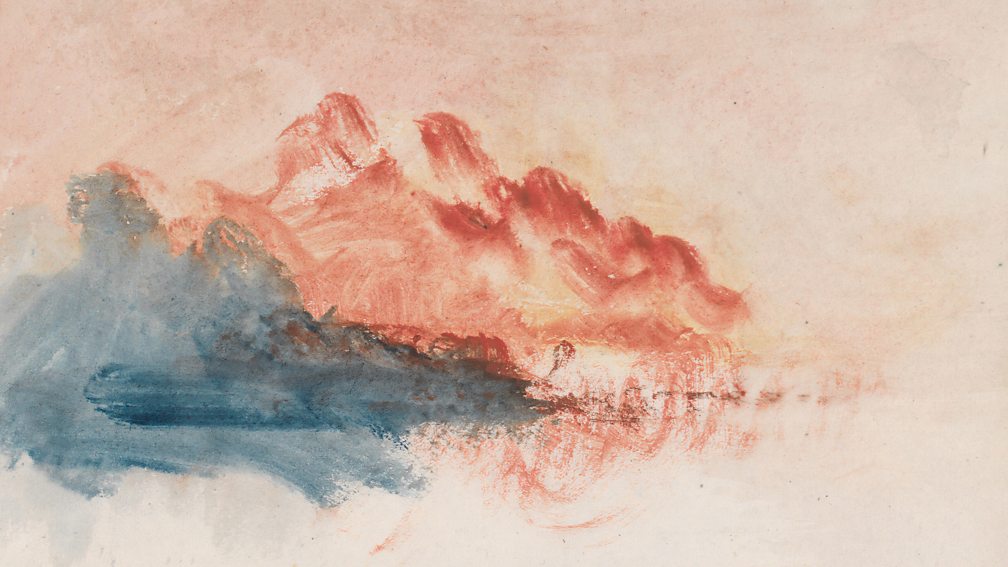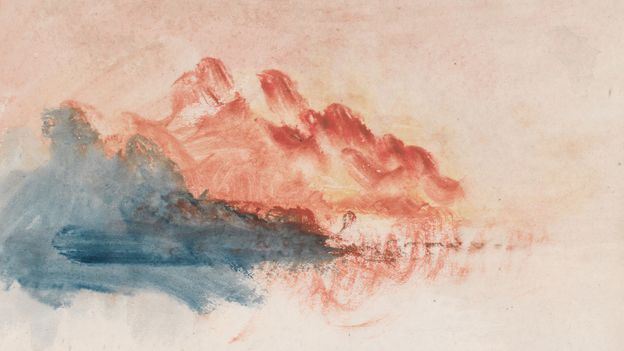By Sarah GriffithsFeatures correspondent

As Fagradalsfjall in Iceland is thought to build towards eruption, researchers look to art, diaries and monks’ records to reveal the long history of the global impacts of volcanoes.
The ability to capture ethereal light, wild weather and romantically hazy landscapes using atmospheric washes of translucent paint made British artist JMW Turner famous.
But when Turner turned his brush to the dreamlike beauty of a sunset, he was inadvertently recording a lot more than the drama of a passing moment. The streaks of scarlet and glowing oranges on his canvases have become a record of volcanic eruptions that created unusually fiery displays at sundown.
It is not only painters like Turner who have recorded the atmospheric effects of violent eruptions in the past but poets, diarists and medieval monks.
As Iceland braces itself for an eruption at the Fagradalsfjall volcanic region near Grindavík on the Reykjanes Peninsula, turning to the eruptions of the past can reveal a host of insights into volcanoes’ atmospheric effects. From incredible sunsets to terrible temporary pollution and cooling, precious records from the past can help us understand the potential impacts of eruptions in the future.
Illuminating paintings
When volcanoes erupt, as well as emitting ash and carbon dioxide, they can spew vast amounts of sulphur gases into the atmosphere. These form tiny particles called aerosols, which reflect sunlight back into space.
“The extra particles in the atmosphere hinder the passage of short wavelength blue light so you’re left with more of the red end of the spectrum,” says Peter Rowley, a physical volcanologist at the University of Bristol, UK. “The same effect is seen in dusty conditions.”
These aerosols can make sunsets especially vivid, an atmospheric phenomenon which has inspired many great works of art and literature. One study analysed sunsets painted by European artists between the years 1500 and 2000, during which time 50 large volcanoes erupted.
“We wanted to provide alternative ways of exploiting the environmental information in the past atmosphere in centuries when instrumental measurements were not available,” says Christos Zerefos, an author of the study and head of the Research Centre for Atmospheric Physics and Climatology at the Academy of Athens in Greece.
They discovered that the colours of sunsets painted by famous artists can be used to estimate aerosol levels in the Earth’s past atmosphere. Their analysis showed that the painters did indeed use more red hues after a major eruption.
You might also like:
The effects of the larger eruptions lingered on painters’ canvases long after the volcanic activity had ceased. Following the 1815 Tambora eruption in Indonesia, which killed at least 70,000 people and unleashed energy equivalent to 2.2 million Little Boy atomic bombs, the changes in the sky could be seen for up to three years around the world.
“Because there’s a lot of heat, you get convection currents mixing volcanic gases and air, which form aerosols, and they are carried around [the world], scattering light,” says Rowley.
This explains how thousands of miles away, painters in Europe including Turner were able to capture the colours of the sky changing in their works of art, from hazy yellows to vibrant vermillion.
The eruption of Krakatau in 1883 was recorded in the yellow sky of impressionist Edgar Degas’ painting Race Horses, and it may also have been the cause of the “blood-red eve” and glaring “wrathful sunset” in the poem St Telemachus by Alfred Lord Tennyson.
“Art expressed in numbers does not only provide beauty, but information about physical parameters,” says Zerefos.
Otherworldly sights
The effects of Krakatau were felt all over the world and even appeared to turn the moon blue.
The reason was the vast quantities of tiny sulphuric acid aerosols or “dry fog” the eruption ejected into the atmosphere. These absorbed red wavelengths of light, leaving proportionally more blue light to reach the surface of Earth. The particles also produced other optical effects including haloes around the Sun called “Bishop’s Rings”.
Unusually coloured lunar eclipses caught the attention of medieval monks who unwittingly recorded volcanic eruptions. Searching the skies for ominous signs, the monks recorded 51 of 64 total lunar eclipses that occurred in Europe between 1100 and 1300. Five of these accounts detailed incredibly dark or disappearing moons, which occur when there is volcanic dust in the stratosphere. Researchers compared these records with data from ice cores and tree rings, to confirm a link between the dark moons and eruptions.
“I never imagined that descriptions penned by monks centuries ago would prove so useful,” says Sébastien Guillet, a paleoclimatologist and physical geographer at the University of Geneva in Switzerland and an author of the study.
One monk’s account from Normandy, France in 1258, shed light on an eruption the previous year on the island of Lombok in Indonesia. The monk wrote “in 1258, there was no summer during summer. The weather was very rainy and cold at harvest time, leading to crop failures. The grapes couldn’t reach maturity; they were green, altered, and in poor health.”
Guillet adds, “To my knowledge, [this is] one of the earliest uses of ‘a year without a summer.'”
Do eruptions cool the climate?
Soon after that grim summer began a period known as the Little Ice Age in Europe and North America, where average temperatures dropped by up to 2C (3.6F), causing societal unrest. The volcanic activity is one factor thought to contribute to this particularly cold interlude, alongside unusual solar activity and changes in ocean currents.
Because of the Sun’s rays that aerosols reflect back into space, volcanic particles can create a cooling effect that lasts for a number of years. This can be intense and deadly – more than 60,000 people died of starvation and disease during the “volcanic winter” triggered by the Tambora eruption in 1815. The eruption of Mount Pinatubo in the Philippines in 1991 caused global temperatures to fall as much as 0.7C (1.3F).
Currently, standard climate projections are thought to underestimate the cooling effect that volcanic eruptions have on Earth’s surface temperature, but compared with the greenhouse gases emitted by human activity, the effect that volcanoes have on the global climate is relatively minor, says May Chim, PhD candidate at the University of Cambridge in the UK, studying the climate impacts of volcanic eruptions.
Even during a period of extraordinarily high volcanic activity, simulations show that it wouldn’t be enough to counteract the effects of global warming. “It’s like a passing cloud on a hot, sunny day: the cooling effect is only temporary,” she says.
Historic health impacts
Of all the changes to the sky after an eruption, vivid sunsets to vanishing moons are the most harmless. Many of the others come with large health and economic risks.
For example, the volcanic ash clouds from the 2010 eruption of the Icelandic volcano Eyjafjallajökull caused the largest closure of European airspace since World War Two and cost the aviation industry an estimated £1.1bn (US$1.4bn) – the global economic impact was put at £4bn ($5bn).
The largest ash plume recorded in the modern satellite era rose almost 58km (36 miles) into the atmosphere from the underwater Hunga Tonga-Hunga Ha’apai volcano in Tonga, and was swept by winds to nearly 1,860 miles (3,000km) west to Australia.
In certain conditions, sulphur dioxide can produce unpleasant-smelling, acidic clouds of volcanic fog, sometimes known as “vog”. A familiar sight in Hawaii, where it sometimes obscures dramatic volcanic vistas, it can put vulnerable people, including those with heart or lung conditions, at greater risk of experiencing breathing difficulties.
Historic records are also helping estimate the potential health risks of large eruptions.
In 1783, a choking haze of sulphurous aerosols formed following a series of volcanic eruptions that started at the Laki fissure in Iceland. The aerosols lingered in the lower part of the atmosphere over Europe throughout the summer, causing tens of thousands of deaths.
Before news of the eruption spread to Scotland, amateur meteorologists and farmers recorded unusual weather. The Aberdeenshire diarist Janet Burnet noted the hazy, foggy weather, leaves prematurely yellowing and crops turning black. Matched up with weather records, diary entries such as this enabled scientists to reconstruct changes in the local climate before, during and after the eruption of Laki.
An eruption on the same scale as Laki, which generated 20 cubic km (4.8 cubic miles) of lava, would endanger lives today. Anya Schmidt, a lecturer in climate modelling at the University of Cambridge in the UK, calculated the hazards the world could face from a future Icelandic Laki-type eruption.
She showed that poor air quality could potentially cause 142,000 premature deaths in Europe depending on the length of exposure to volcanic air pollution in the first year, making it more deadly than seasonal influenza.
However, Phil Colins, dean and reader in geology and geotechnical engineering at Brunel University London, says that the potential eruption at Fagradalsfjall in Iceland is not likely to be similar in scale to the Laki eruption. Nor is as much disruption to travel expected as Iceland’s 2010 Eyjafjallajökull eruption, he says, as that eruption was made more disruptive by a glacier over the volcano. “This supplied water to the erupting magma, generating steam and leading to the creation of fine particles,” says Colins.
The effects the eruption would have should there be one, are hard to predict.
“It is extremely challenging to forecast when and where an eruption may begin,” says Margaret Hartley, lecturer in earth sciences at the University of Manchester, UK.“The level of disruption to lives, infrastructure and tourism all depends on where the magma breaks the surface, and the size and style of the eruption.”
—
If you liked this story, sign up for The Essential List newsletter – a handpicked selection of features, videos and can’t-miss news delivered to your inbox every Friday.
Join one million Future fans by liking us on Facebook, or follow us on Twitter or Instagram.

